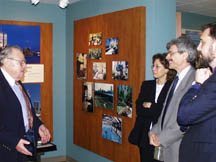When Newport was nothing more than the railroad-covered, desolate industrial wasteland it was up until the mid-1980s, the Soviet Union was still controlled by Communists. The Cold War was just beginning to thaw as democracy slowly tiptoed into Mother Russia. Perhaps it was fitting then that last week city planners and professors from St. Petersburg, Russia visited Jersey City to study the sub-city that now sits atop those old railroad tracks and gutted factories in Newport. It was apparent, as Dr. Samuel LeFrak, chairman of the Lefrak Organization spoke to his Russian guests in front of assorted members of the media on Thursday, that the sweeping winds of change were blowing in Russia just as they had near the mighty Hudson. “You’ve got to change with the world,” LeFrak said. The conference was part of a University of Maryland Urban Studies and Planning exchange program. The university’s goal, according to a recent press release, was to analyze, with the Russians, how the Lefrak Organization is developing the 600-acre Hudson River community and how it transformed dilapidated rail yards and abandoned warehouses into residences and office buildings. “They want to come over here and learn from us,” LeFrak said. Lefrak took the Russians and the media through his administrative offices, where there is a virtual gallery of all of the Lefrak Organization’s projects in Newport, including models, posters and architectural drawings. With his city surrounding them in 3-D, LeFrak discussed how Newport was born from the train sheds. “Before we started building here,” LeFrak said, “there was not one blade of grass, and not a tree. But I saw what potential it had … It was just a horror.” Today, Lefrak said that after planting over 90,000 tulip bulbs, Newport could be mistaken for Holland. LeFrak told the Russians about the amenities that have made Newport a success. He listed the many transportation outlets available for commuters. And some residents work in one of Lefrak’s Newport Office Center buildings, just across Washington Boulevard from the residential towers. “We have all the access to transportation,” LeFrak said. “Nowhere in New York City is there as much access to transportation as we have here.” Newport has its own ferry station, PATH terminal, bus routes and soon-to-be light rail stop. The visitors compared the PATH station outside, renovated by LeFrak’s company for a cool $22 million, to their own subway systems in Moscow. According to LeFrak, the “city” of Newport has generated 100,000 jobs for Jersey City and will eventually house 50,000 residents in its apartment complexes. Among the improvements to the area over the years, he listed the addition of the Newport Mall and its movie theater; four department stores; a golf course that will be added to Liberty State Park; and the Liberty Science Center. “They come from New York to go to the science museum,” LeFrak said, “and they have the Academy of Science there.” LeFrak told the Russians that affordable housing is the key to building their own “tech city.” Newport will house over 7 million square feet of real estate. However, this was a number the Russians could not understand. One of the professors converted the number into square meters for them. The developer also compared the rates he charges per square foot to the rates charged in Manhattan. In Newport, the rates are somewhere in the neighborhood of $22 to $23 a square foot versus upwards of $50 in New York. “I can’t build them fast enough,” LeFrak said of the apartment buildings, some of which have been rented before completion. “It’s a miracle.” Da! LeFrak told the Russians that they have to have a reason and a purpose to build their own little sub-city. He stressed affordability for residents and tenants, and said a friendly government doesn’t exactly hurt either. “You’ve got to have a friendly climate,” LeFrak said. “I came here to Jersey City, where all the mayors were thrown in jail.” To that, the Russians laughed and said that the same is true in St. Petersburg. Newport could not be possible, LeFrak said, without the Harvard-schooled Bret Schundler as mayor of Jersey City. The developer cited tax abatement programs that have allowed his buildings to look attractive to businesses looking to relocate their headquarters and back offices to Jersey City. “The northern tier of New Jersey is really a part of Manhattan,” LeFrak said. As far as St. Petersburg goes, the Russians said that they have a long way to go in redevelopment. Similar to Jersey City, the Russians said that St. Petersburg has an ideal waterfront for a Newport-type community. “It’s a beautiful, historic city,” Leonid Limonov, director-coordinator of research programs for the Leontief Centre for Social and Economic Research, said of St. Petersburg. “But there hasn’t been much development for at least 10 years.” Most of the architecture there is from the old industrial times, with Soviet government buildings and state-built structures lining the streets, said Ephim Schluger, an urban development specialist. “The standards were not very high,” he said. The Russians said that finding investors will be the biggest challenge in redeveloping St. Petersburg. They said that suburbs are not popular in Europe and that the majority of the people live in the cities. Therefore, the idea to employ and house residents in the same section of the city, on the waterfront, certainly makes sense for St. Petersburg. LeFrak said that without the backdrop of the New York skyline, the idea to create Newport would have taken a lot longer to achieve. He pointed out to the Statue of Liberty and across the intersection of the Hudson River and New York Harbor, and said that nothing sells better than the view. “Where in the world are you going to find this?” LeFrak said. “Look at the views these people have.”
Moscow on the Hudson: Russian city planners examine Newport
